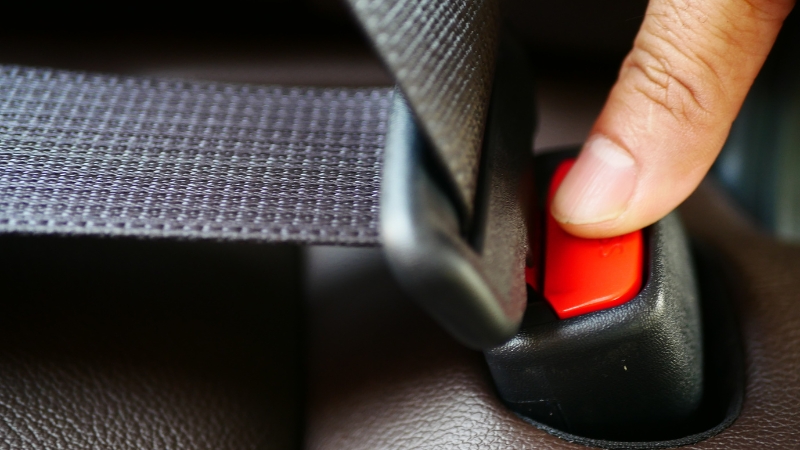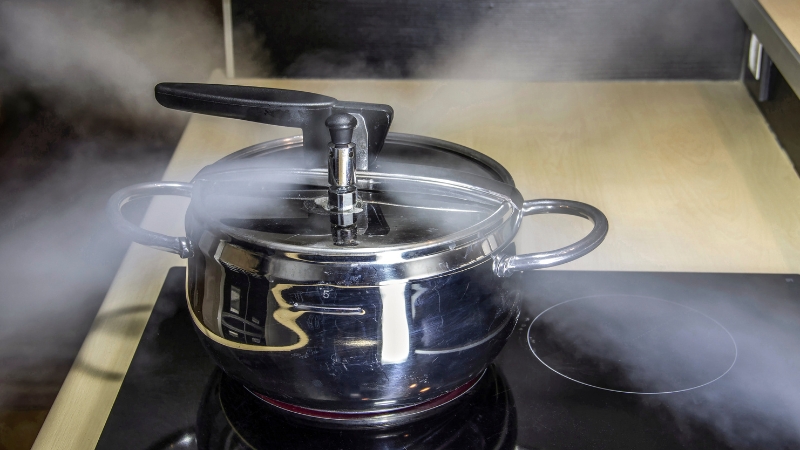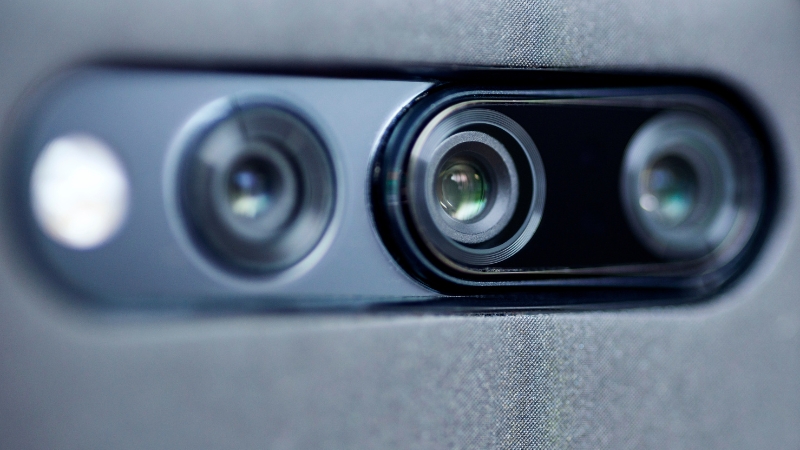Physics is not only about chalkboards and equations. It’s woven into every moment you live – from your morning coffee to your commute, from your phone’s GPS to the way your headphones cancel noise.
Each example below connects a familiar activity to the principles behind it. Let’s take a closer look.
Speed, Energy, and Safety

Cars, bikes, and buses all obey the same physics of motion. On the road, speed, energy, and safety go hand in hand, shaping how every trip unfolds.
Kinetic Energy and Stopping Power
A moving car carries kinetic energy, and the faster you go, the more energy you store, a principle straight out of classical mechanics lessons. Kinetic energy increases with the square of speed. Double your speed and the energy quadruples.
The U.S. Federal Highway Administration explains that vehicle kinetic energy is proportional to speed squared, which is why high-speed crashes are so severe.
Data from the Insurance Institute for Highway Safety and the AAA Foundation show that raising impact speed from 40 mph to 50 to 56 mph pushed crash energy beyond what vehicle safety structures can absorb, sharply increasing injury risk.
NHTSA echoes this pattern: higher speeds increase both crash probability and injury severity, even with modest speed differences.
Seat Belts and Airbags
Seat belts and airbags apply impulse, a physics term for force over time, to slow your body more gently. By stretching the stopping process over a few extra milliseconds and centimeters, they lower peak forces on bones and organs.
NHTSA reports that wearing a seat belt in the front seat cuts the risk of fatal injury by nearly half. Crumple zones work the same way: instead of stopping you instantly, the car’s front end deforms to absorb energy.
Heat and Temperature

Heat and temperature shape more of your daily routine than you might think. From the speed of cooking dinner to the comfort of your living room, the flow of thermal energy quietly drives how fast things warm, cool, or hold their heat.
Pressure Cookers
Water boils at 100 °C at sea level, but in a sealed pressure cooker, the internal pressure increases and the boiling point rises. Food cooks at higher temperatures, often around 120 °C, so tough cuts and beans soften much faster.
Engineering references show how boiling point changes with pressure, and the U.S. National Institute of Standards and Technology (NIST) keeps detailed water property data that underlie those numbers.
Refrigerators and Heat Pumps
A refrigerator does not make things “cold” so much as it moves heat out. Using a compressor, condenser, expansion valve, and evaporator, it transfers heat from inside the fridge to your kitchen air.
The U.S. Department of Energy (DOE) explains how heat pumps use the same principle on a larger scale to heat and cool homes.
Because they move heat rather than create it, air-source heat pumps can deliver about two to four times more heat energy than the electricity they consume.
Windows and Low-E Coatings
Heat crosses window glass by conduction, convection, and radiation. Low-emissivity (low-e) coatings reduce radiant heat loss dramatically.
According to DOE consumer guidance, low-e windows cut energy loss by about 30 to 50 percent compared with standard windows. Inert gas fills like argon or krypton further slow conduction.
Thermoses and Insulation
A vacuum flask combines multiple defenses against heat loss:
- A vacuum layer to limit conduction and convection
- Reflective surfaces to reduce radiation
The same idea shapes home insulation strategies, just scaled up.
Kitchen Electromagnetism
View this post on Instagram
Electromagnetic fields do a lot more in your kitchen than you might think. From induction cooktops to microwave ovens, the science of moving charges and oscillating fields quietly powers faster, cleaner, and more efficient ways to cook.
Induction Cooktops
An induction hob uses rapidly changing magnetic fields to induce electric currents in a ferromagnetic pan. The pan itself heats through resistance, giving fast response and less wasted heat in the kitchen air.
DOE efficiency studies show induction is significantly more efficient than gas and standard electric resistance.
Microwave Ovens
Microwave ovens use electromagnetic waves at about 2.45 GHz (confirmed by the FCC) to excite water molecules and other polar compounds in food.
The U.S. FDA enforces safety standards for these ovens. Because the waves penetrate a few centimeters into food, they heat it quickly and evenly without relying on conduction from a hot surface.
Lighting
The light-emitting diode (LED) is today’s most energy-efficient and rapidly developing lighting technology.
Quality LED light bulbs last longer, are more durable, and offer comparable or better light quality than other types of lighting.— Vijaycenaorton (@VijayCenaOrton) October 13, 2024
Light-emitting diodes (LEDs) convert electrical energy directly into light by electron-hole recombination at a semiconductor junction. This process produces far less waste heat than incandescent bulbs.
According to DOE’s Energy Saver, LEDs typically use at least 75 percent less energy and last many times longer than incandescents. Swapping bulbs is one of the simplest ways to cut home energy use.
Sound and Waves
Sound shapes so much of daily life, from the volume of your commute to the clarity of your headphones. A few core wave principles quietly protect your hearing and power the tech you use to listen.
Noise-Induced Hearing Loss
Sound is mechanical vibration traveling through air. Intensity is measured in decibels (dB), a logarithmic scale.
NIOSH guidelines say 85 dBA for eight hours is the recommended exposure limit, and every 3 dB increase halves the safe time. That’s a direct measure of how sound energy accumulates on delicate inner-ear cells.
Active Noise Cancellation
Active noise-cancelling headphones use microphones and signal processors to create a sound wave that’s the mirror of incoming noise.
When combined, the two waves cancel each other (destructive interference), reducing what reaches your ears. Audio engineering texts describe this principle in clear terms, linking it to wave superposition taught in physics classes.
Light and Optics All Around You

Light shapes what you see every day, from the color of the sky to the way sunglasses cut glare. A few simple physics ideas explain why.
Polarized Sunglasses
Glare from water, snow, or glass is often light polarized by reflection. Polarized lenses have a transmission axis that blocks the dominant polarization, cutting glare and revealing more detail.
University optics labs and outdoor-gear makers show how this boosts safety for drivers, boaters, and skiers.
Why the Sky Appears Blue and Sunsets Glow Red
Shorter wavelengths of sunlight scatter more off atmospheric molecules. Midday skies look blue because of Rayleigh scattering, while sunsets pass through more air, scattering away the blues and leaving reds and oranges.
NASA’s Earth Observatory provides detailed yet accessible explanations of this effect.
Phones, Sensors, and Cameras

Your smartphone is packed with tiny laboratories of physics. From sensing motion to capturing light and plotting your exact location, it relies on principles like acceleration, vibration, and the photoelectric effect to make everyday features feel seamless.
Accelerometers and Gyroscopes
Smartphones know their orientation through MEMS sensors. A MEMS accelerometer is a tiny mass on springs etched into silicon. When you accelerate or tilt, the mass moves, changing capacitance, which electronics read out as motion data.
NIST and NASA have published primers on how these sensors are tested and fused with gyroscopes and magnetometers for stable orientation.
Gyroscopes sense rotation using vibrating structures and the Coriolis effect. This tech is everywhere now – drones, game controllers, fitness trackers – enabling smooth measurements of angular motion.
Smartphone Cameras and the Photoelectric Effect
A phone’s camera sensor converts light into an electronic signal via the photoelectric effect. Photons free electrons in silicon pixels, which are then read and processed into images.
GPS and Relativity Corrections
Your phone’s GPS depends on satellite clocks running tens of thousands of kilometers away. Because the satellites move fast and sit in weaker gravity, their clocks tick at slightly different rates than Earth’s clocks.
Without compensating for Einstein’s relativity, GPS would drift by about 38 microseconds per day, creating errors of kilometers.
NIST and NASA detail the corrections that keep positioning accurate to a few meters.
Wi-Fi, NFC Pay, and Wireless Charging

Wireless tech isn’t just for convenience; it’s built on real physics. From Wi-Fi signals to tap-to-pay and cordless charging pads, electromagnetic fields make your everyday connections seamless.
Wi-Fi Bands
Wi-Fi runs on multiple frequency bands.
- 2.4 GHz travels farther but carries less data.
- 5 GHz and 6 GHz support higher speeds over shorter distances.
Intel and IEEE 802.11 standards outline which versions use which bands, helping you pick the right one at home.
Tap-to-Pay with NFC
Contactless cards and phones use near-field communication at 13.56 MHz, a short-range electromagnetic link governed by ISO standards.
The NFC Forum shares public specs about how the system exchanges secure data during a tap-to-pay transaction.
Wireless Charging
Qi wireless charging uses magnetic induction. A coil in the charging pad generates a changing magnetic field, inducing a current in a matching coil inside the phone.
The Wireless Power Consortium sets the frequency ranges and interoperability standards for this system.
Solar Panels and Heat Pumps
@equans_group Hugo breaks it down: What is photovoltaic energy? 🌍⚡ Learn how the sun powers our future with Equans! #SolarEnergy #Innovation #Equans ♬ Messy – Lola Young
Homes can produce and move energy more efficiently than ever. Solar panels turn sunlight into electricity, while heat pumps shift warmth instead of generating it, cutting costs and emissions at the same time.
Solar Photovoltaic Panels
Solar cells turn sunlight into electricity by creating electron-hole pairs at a semiconductor junction. According to the U.S. National Renewable Energy Laboratory (NREL), typical residential panels convert about 20 percent of sunlight into electricity.
Higher-end panels push above 22 percent efficiency. That means a good-sized roof can power much of a home’s daytime needs.
Heat Pump Efficiency, Revisited
Because heat pumps move rather than make heat, their coefficient of performance (COP) often falls between 2 and 4 for air-source units.
DOE consumer guides explain how to interpret these ratings and why they outperform electric resistance heating in many climates.
Sports and Weekend Physics

Weekend activities are full of hidden science. Whether it’s a bike ride, a pick-up game, or a spin on the tennis court, the same physics that governs highways and gadgets shapes speed, spin, and performance on the field.
Cycling and Air Resistance
At typical cycling speeds, most of your energy fights air drag. Drafting behind another rider cuts drag dramatically.
Wind-engineering research led by Bert Blocken showed large reductions in air resistance for trailing cyclists in a paceline, confirming what every road rider feels.
Curving Balls and the Magnus Effect
Spinning a soccer ball or baseball produces lift forces that bend its path. This is the Magnus effect, arising from pressure differences as air flows differently over a spinning surface.
NASA Glenn Research Center’s education pages unpack the phenomenon, linking it to memorable goals and curveballs.
Everyday Situations and the Physics Behind Them
| Situation | What’s Really Happening | Practical Takeaway |
| Braking from higher speed | Kinetic energy grows with speed squared | Lower speed saves a lot of stopping distance |
| Wearing a seat belt | Longer stopping time lowers peak force on your body | Buckling up about halves fatal injury risk |
| Pressure cooking | Higher pressure raises boiling point | Faster cooking at higher temperature inside the pot |
| Induction cooktop | Changing magnetic fields heat the pan directly | Fast, efficient heating with precise control |
| Microwave oven | 2.45 GHz fields agitate polar molecules | Efficient heating for water-rich foods |
| LED bulbs | Semiconductor light emission with low waste heat | Big electricity savings vs incandescents |
| Polarized sunglasses | Filter blocks glare’s dominant polarization | Clearer vision on water, snow, wet roads |
| Phone orientation | MEMS sensors detect acceleration and rotation | Auto-rotate, step counting, and AR all depend on this |
| GPS navigation | Precise timing with relativity corrections | Everyday accuracy of a few meters on your phone |
| Wi-Fi choice | 2.4 GHz for range, 5/6 GHz for speed | Pick bands based on walls, distance, and congestion |
Practical Tips You Can Use Right Away
- Drive a little slower. Even a modest drop in cruising speed slashes kinetic energy and improves stopping distance.
- Buckle up every ride. The physics of impulse is on your side, and so are the stats.
- Cook smarter. Pressure cookers use higher boiling temperatures to cut cooking times for beans, lentils, and stews.
- Upgrade lighting. LEDs cut power bills and heat output.
- Seal the envelope. Low-e windows and good weather-sealing make heating and cooling systems work less.
- Pick the right Wi-Fi band. 2.4 GHz for range through walls; 5 or 6 GHz for higher speeds nearby.
- Protect your hearing. Watch exposure time at high volumes, especially with earbuds or in loud workplaces.
Wrapping Up

Every time you hit the brakes, cook dinner, or scroll on your phone, you’re seeing physics principles in action. They quietly keep you safer, make your home more efficient, and power the gadgets you rely on.
By spotting the patterns: kinetic energy, heat transfer, waves, and fields, you can make smarter choices, from picking better lighting to safeguarding your hearing.

